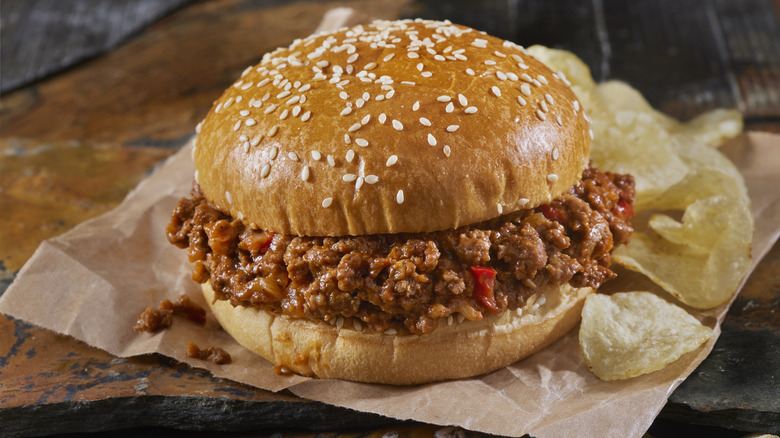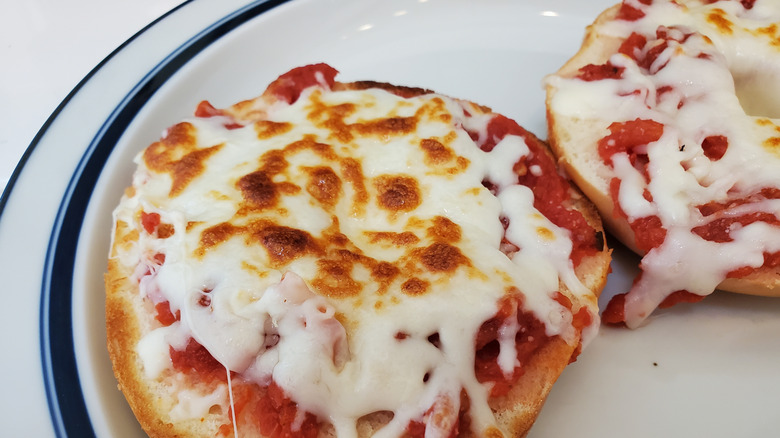The Affordable Meal That You Probably Ate As A Kid In The '90s
So often, it's not the most intricate gourmet meals that imprint strongest in memory — but rather childhood ones. It's humble dishes like the best boxed mac and cheese, Hamburger Helper, and an icebox pie that typically hit emotional recollections. And if you grew up as a kid in the 90s, here's another offering that might deliver childhood nostalgia: A sloppy joe served with a side of chips.
Found at home or in the school cafeteria, that dish offers foolproof flavors for kids (and adults) of all ages, all while going easy on the budget. Sure, sloppy joe recipes do vary a bit, but it's likely the ketchup, garlic powder, vinegar, and brown sugar seasoning that transports you to another era. It's sweet and savory, not overly complex, and oh so delicious — especially when served on the ubiquitous classic hamburger buns you can find.
The meal comes mushy, messy, and requires hands-on eating — added points for childhood nostalgia. So that's precisely where the chips come in. Ideally, these crispy spuds come ladled out of a large family-sized bag, in the classic unflavored variety. They offer another finger food component that contrasts sloppy joe flavors with texture and salt. You might have even stuffed them inside the bread, forging a bite still remembered decades down the line.
Sloppy joes were popular throughout the 20th century
By the time the 90s rolled around, the sloppy joe had already satisfied diners for decades. No one quite knows the sandwich's origin — dueling theories point towards either Iowa in the early 1930s or Cuba in 1910. According to urban legend, even Ernst Hemingway took a liking to the dish, leading to its availability at the still-operating Sloppy Joe's Bar in Key West, Florida.
Regardless of early lore, the sandwich firmly established itself in American cuisine by the late 1940s. With its characteristic messy composition and likable sweet-meets-umami flavor, it didn't take long for the dish to spread from taverns to the family dinner table. Already by the 1950s and 60s, newspaper clippings reported on the sloppy joes' enjoyment in cafeterias and as an easy-to-prep meal for kids. Recipes proliferated, emphasizing cost-effective convenience matched with ingredient variability.
Furthermore, the availability of manufactured foods spurred creation along. First came the canned Libby's sloppy joe brand, advertised by the mid-1960s. Yet at the tail end of the decade in 1969, Hunt's Manwich sauce debuted, and took the popularity of sloppy joe to a new realm. Still in production, this aromatic tomato sauce truly spread the joys of the sandwich nationwide. Easing assembly to only ground beef, bread, and a can of sauce, it enabled both large-batch cafeteria renditions and a no-fuss after-school creation. The flavor seeped so strongly into the American palate that it even led to sloppy joe alternatives without a bun. So by the 1990s, the sloppy joe carried its iconic status into a new generation.
Recollect potato chip sloppy joes and a range of other nostalgic 90s meals
Undoubtedly, sloppy joes and chips make the highlight reel of 90s classics. And it might make you reminisce over other entrees in the category. To start, don't leave the 20th-century classic tuna casserole off the list. Sure, a 21st-century version involves some raw tuna and soba, but back in the previous century, it was all about canned tuna and soup, matched with a generous portion of cheese over the noodles. It's hard to imagine a dish more fitting of the comfort food category — and it certainly won points in cost-effectiveness, too.
Meanwhile, for an entrant more specific to 90s culture, there's the pizza bagel. Americans loved tomato sauce and cheese on everything, including bagels. Also a kid-friendly classic, this dish can integrate just about any topping as long as there's mozzarella cheese, and a slice or two of pepperoni for good measure. Sure, it doesn't have the sophistication of a scratch-made pizza dough and specialized oven, but it certainly hit the spot.
And finally, don't forget the fusion meal that's Chinese Chicken Salad. Widespread on restaurant menus and potlucks at the time, this dish pushed the envelope of textures and flavors (perhaps with greater appeal to adults). There's lettuce combined with nuts or uncooked ramen, usually citrus, and that unmistakable ginger-soy-sesame-honey dressing. Recreate any of such dishes, and take a bite — they'll transport you to another era.



